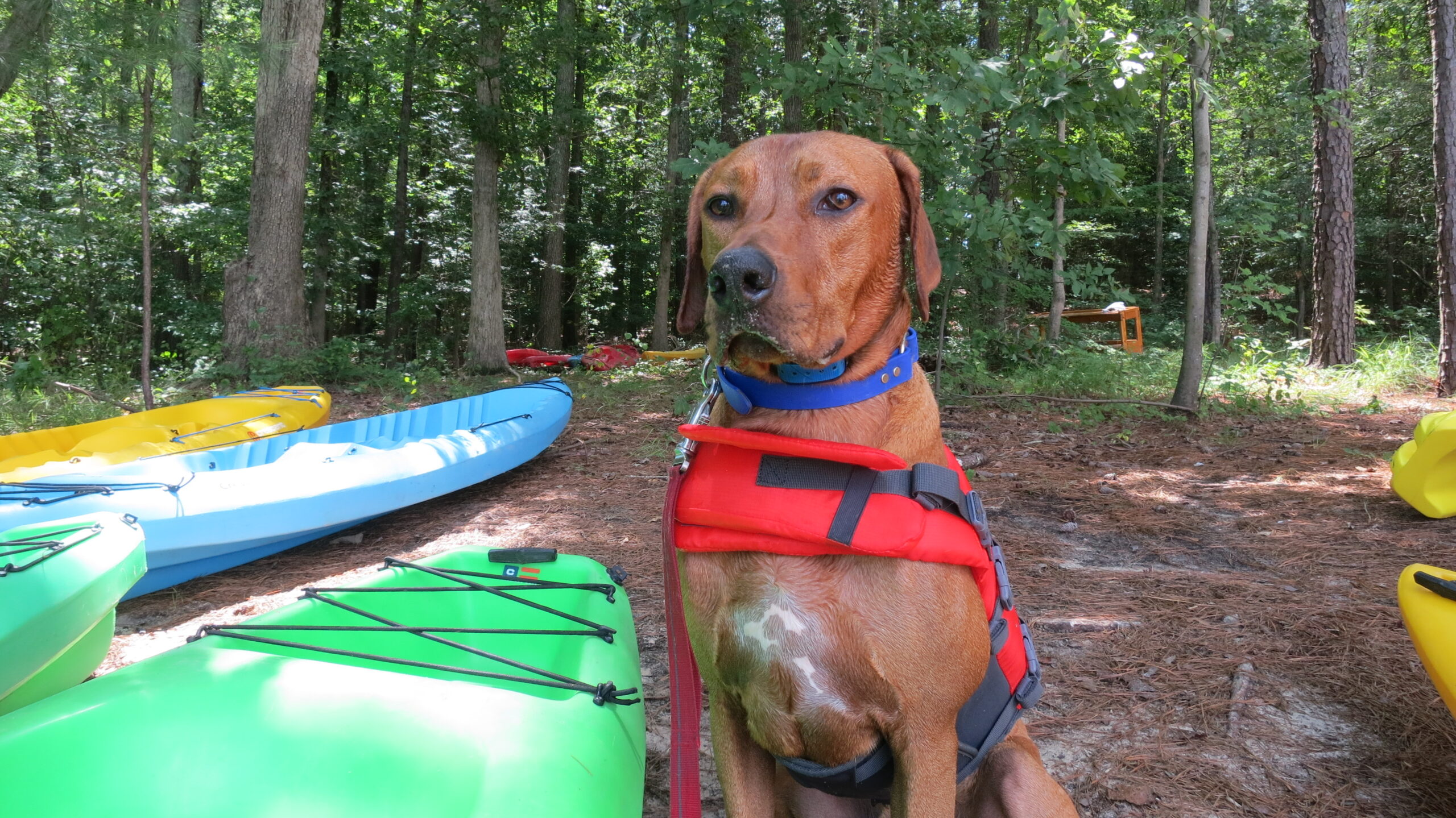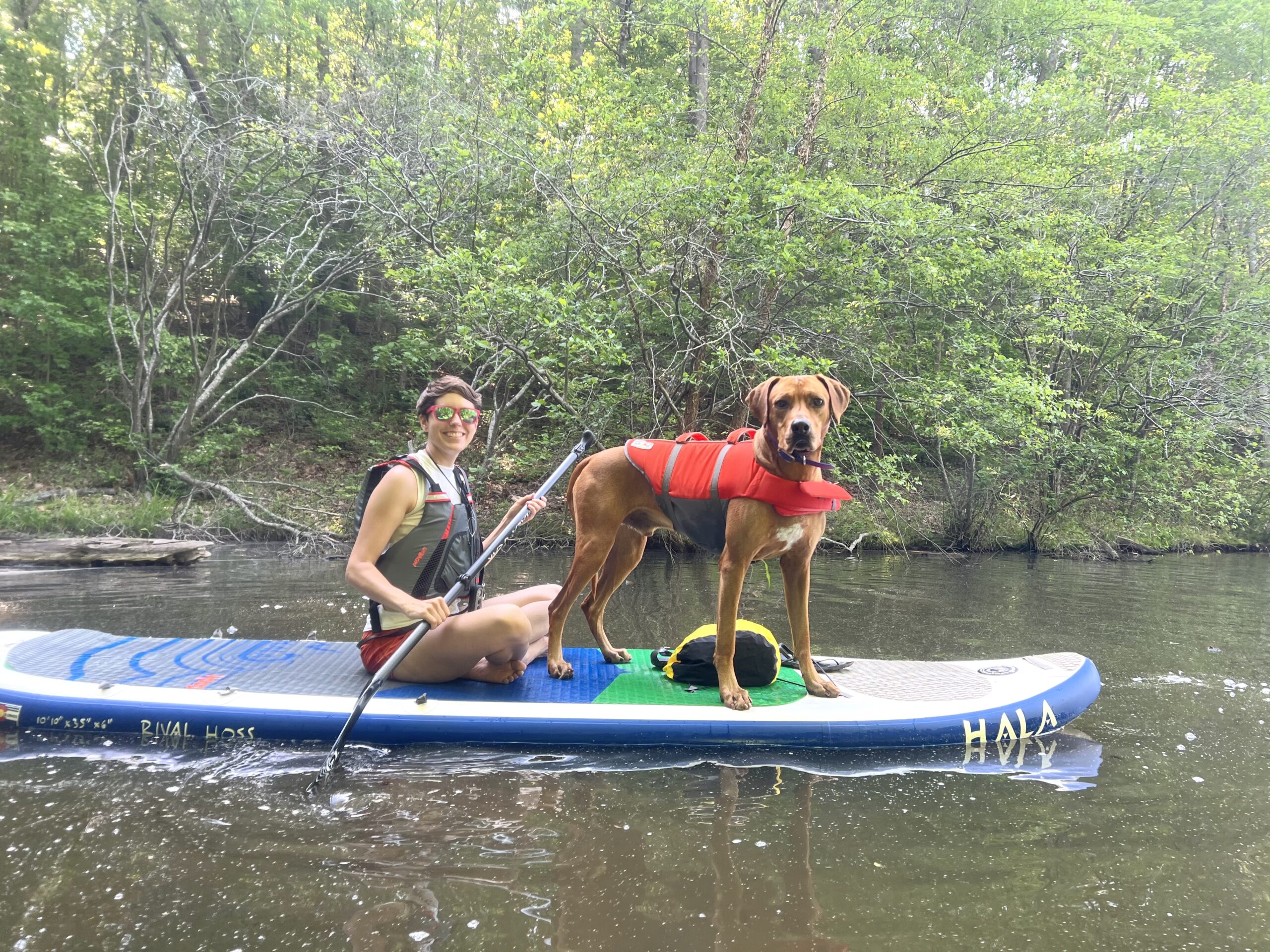Now that the weather is warm (at least here in the South), I’ve taken my stand up paddle board out of storage. I went stand up paddle boarding for the first time in 2015 and since then, have made an effort to do so every summer. I had always rented SUPs, but last year, I finally decided to buy my own. It’s also an activity I enjoy doing with my dogs. If you have never taken your dog stand up paddle boarding, there’s a few things to consider before you put them on a board.
Early Exposure is Ideal
I did not take Zara on a SUP until she was about a year and a half. However, we had taken her kayaking when she was about 10 months old. On the other hand, Colombo had his first experience on a paddle board when he was five months old. If possible, I think it’s helpful to expose your young dog or puppy to a SUP. If it’s something you plan on doing with them regularly, getting on a SUP as a puppy is an important part of socialization.
I think Colombo may have been a little nervous when he first tried it out, but since Zara was there and we kept it short and positive, he was fine. By the time I took him out the next summer, when he was over a year old, he acted like an old pro.

The first time Colombo went stand up paddle boarding. He was about five months old.
Training Helps
While not essential, depending on the dog, it can be helpful to work on some specific training before you take your dog paddle boarding. You’ll want your dog to have some basic obedience for this activity. A dog that is calm and relatively stationary is the best type of SUP companion. If you have your own paddle board, or know someone who does, you can work on getting them comfortable with the board at your house before you take it out on the water. When I first bought my board, I blew it up in the living room and let the dogs climb on and off of it. You could also do a quick training session with a rental board before you put it in the water. The SUP will be much more stable on land than once it’s in the water.
Ideally, your dog should know sit/down and stay commands before you take them out. Although it’s not crucial for them to be sitting or staying in one place at all times, the more control you have, the better. You may want them to sit and stay for a short period while you adjust something or navigate through an area with distractions (ducks, geese…). A “place” command is also helpful. If your dog understands place, then they should know that they can’t leave the paddle board (i.e. leap off) until you give them a release word. Although I haven’t used “place” in conjunction with the SUP, I think it could be very useful for some dogs.
In general, being consistent about the behavior you want will pay off. For example, if it’s just me and Colombo on the board, I sit a little more than halfway back and I want him in front of me, either in the middle of the board or at the very front. The weight distribution works the best this way. If he’s behind me, the back of the board gets weighed down. If he ends up behind me, I’ll ask him to move forward. Doing this enough means that he generally stays in the area I want him.

I definitely used “sit” and “stay” commands to take this photo. However, I don’t usually let my dogs hang out on the paddle board without me on it. I don’t want them to accidentally flip it and have a bad experience.
Know Your Dog
I think many dogs can enjoy paddle boarding with their humans. Exposure, training, and repetition go a long way. However, you should understand your dog’s personality, temperament, and activity level and decide if paddle boarding is actually an activity they will enjoy or not. Colombo is a great SUP dog. I think he really enjoys being on the board, floating along and watching things. He readily jumps on the board as soon as I put it in the water and even if he falls off, he shakes it off and doesn’t seem bothered. He mostly stays in one place on the board and and he doesn’t whine or cry. This is all with minimal training. He’s like this on the SUP because he’s like this most other places – chill and content to be with his people. That’s partially his breed and partially his personality (and age – he’s five now).
Zara, on the other hand, is not really what I would call a good SUP dog. She has no issues getting on and off the SUP, is not afraid of it, and will ride along and obey commands if I give them. However, she’s an active vizsla, and hanging out in one spot is not really her favorite thing to do. She moves around a lot and will start whining. I have not taken the time to train her to stay on the board and be calm. After I bought my SUP last year, we spent a lot of time at the local lake and with hardly anyone around, I allowed her to swim freely or run the shoreline while I paddle beside her. This generally works best for everyone involved. If we go to a more crowded lake or are in a river, I can’t let her do this as much. In those situations, I will bring a bumper and allow her to retrieve it off the board until I decide it’s time to stop. I will also take breaks to allow her to get off and be on land for a few minutes.

Colombo is content to ride on the board for as long as I want.
Renting vs Buying a SUP
There are plenty of articles about there about how to choose a SUP if you want to buy one, so I’ll only touch on this briefly. I rented SUPs for six years before I decided to buy one. A well-made one is not cheap ($750 is probably the lower end of what I would spent for a good board, although you can find lesser-quality ones that are in the $400 range), so that’s why I felt like I couldn’t justify the cost. Eventually, I felt like it was worth it because I live 10 minutes from a public lake and I knew it was something I would use regularly. In Raleigh, North Carolina, where I live, you can easily SUP for six months out of the year (April through October). I probably took it out about once a week last summer and it took the place of my afternoon dog walk/hike/training session. On those hot 90+ degree days, being on the water was where I wanted to be anyway.
When I looked for a board, I wanted something that was very stable and could hold at least 275 pounds (the combined weight of my dogs and I). In my research, I found that wider boards are the most stable. Some paddle boards are made for racing and speed – that’s not what I needed. I wanted something durable and stable with a large foam pad to provide traction for the dogs. I ended up purchasing an inflatable Hala Rival Hoss (it doesn’t look like they make that exact one anymore, but the Hoss is similar). It holds 350 pounds, is wide and long, and the foam deck pad covers almost the whole board. I also liked that Hala offers a five year warranty, which was the best I’ve seen when comparing other manufacturers.
I also went the inflatable versus solid route. It seems like the majority of SUPs are inflatable now. I know dog owners can sometimes be concerned about their dogs’ nails popping the board, but I can assure you that the inflatable board I have is VERY well-made. It does not feel flimsy or fragile at all. Of course, keeping your dogs’ nails short and rounded is always a good idea.
Essential Gear
After paddle boarding with dogs for several years, there are several items that I think are useful to have when you go out. I think a well-fitted dog life jacket is the most important thing to have when you’re paddle boarding with your dog. All of the dog life jackets I have seen have at least one handle on top. This is the most important feature. If your dog leaps off the board or falls in accidentally (trust me, it happens), the handle on the life jacket really helps get them back on the board. Colombo is about 95 pounds and has a very long body. Without a life jacket, I would find it very difficult to haul him back on the board. I have hoisted Zara back up with her collar, but I prefer to grab the life jacket handle.
A life jacket is just a good safety precaution. Ideally, your dog should be a strong swimmer and comfortable in the water before you take them out on a SUP. Even if they are, a life jacket gives an extra layer of protection if they end up the water unintentionally and get tired or a current starts sweeping them downstream.
Other helpful things to bring include leashes, a dry bag to store things like your keys, water, a collapsible dog bowl, poop bags, a bumper/toy, and an e-collar if your dog is trained to one.

Colombo and Zara both have dog life jackets from Outward Hound. They are relatively inexpensive and have lasted. We’ve had Zara’s for close to 7 years.
Don’t Expect to Stand Up Right Away
I know the sport is called “stand up” paddle boarding, but when I’m out on a SUP with my dogs, I hardly ever stand up. You will feel much more stable sitting or kneeling at first. And that’s one of the reasons I enjoy paddle boarding – you’re not stuck in one position like in a kayak. Even though Colombo is relatively stationary on the board, I haven’t gotten up the courage to stand with him yet. Since he’s so big, a sudden movement or lean to one side really throws off the balance of the board. I may try it soon – I will just have to be vigilant about watching him!
Standing up and being able to balance requires that your dog stay in one place. This will likely mean some training. I haven’t put in the time yet to have either one of my dogs calmly sitting or laying in one place for an extended period of time. If you have more than one dog on the board, it’s crucial that they either stay in one spot, or at least keep to a certain area. With mine, I prefer Colombo in front of me to balance my weight, and Zara behind me. Zara can be in front of me and the board still feels fine, but they both cannot be behind me or the front tips up.
How to Get Your Dog Back on the Board
Even if your dog is well-behaved and stays calmly on your SUP, at some point, they may jump or fall off, or you may need to hoist them back on the board in deep water. When the water is shallow, it’s usually very easy for a medium- or large-sized dog to get on a SUP. Mine just hop on when the water is only a foot or so in depth. Deep water is different.
It’s pretty easy to get them back on when they’re wearing a life jacket with a handle. Ideally, position your board perpendicular to the dog and straddle it for stability. As they approach the board, they will put their front paws up. It’s easiest if they are trying to get on in the middle of the board in front of you. Grab the life jacket handle and pull up while shifting your weight away from the dog. Given that your dog wants to get on the board, they usually help with the effort, so hoisting a big dog is not much of a problem. I read an article one time that said you could also position your foot in the water as a step for the dog to get its back feet on. I haven’t tried that method, but it may work for a large dog.
Have you ever tried stand up paddle boarding with your dog? Does he or she enjoy it? Leave me a comment below!

Zara and I paddle boarding in the Potomac River near the Key Bridge in Washington, DC.





